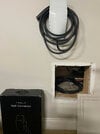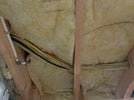What is the maximum length of 6/2 romex for a wall connector on a 50A breaker? Is there a chart or reference I could use?
I'm installing a Tesla Wall Connector (3rd Gen) in preparation for my Model Y delivery in a couple weeks. I bought a 125 ft. 6/2 Stranded Romex , and the run is about 110' through the basement to an interior garage wall (I just followed the path of our existing romex wires to the garage wall). I have about 15' left over, and was going to leave that extra 15' of slack in the wall cavity in case we wanted to move the wall connector to another spot in the garage. If I needed to change anything, I would prefer to downsize from a 50A breaker to 40A versus installing 4AWG wire.
I have an electrician scheduled for a service call for another item, but he is booked about a month out and there is a lot of information out there on wall connectors for self-install. I just couldn't find anything on the run length limits. Thanks!
I'm installing a Tesla Wall Connector (3rd Gen) in preparation for my Model Y delivery in a couple weeks. I bought a 125 ft. 6/2 Stranded Romex , and the run is about 110' through the basement to an interior garage wall (I just followed the path of our existing romex wires to the garage wall). I have about 15' left over, and was going to leave that extra 15' of slack in the wall cavity in case we wanted to move the wall connector to another spot in the garage. If I needed to change anything, I would prefer to downsize from a 50A breaker to 40A versus installing 4AWG wire.
I have an electrician scheduled for a service call for another item, but he is booked about a month out and there is a lot of information out there on wall connectors for self-install. I just couldn't find anything on the run length limits. Thanks!





